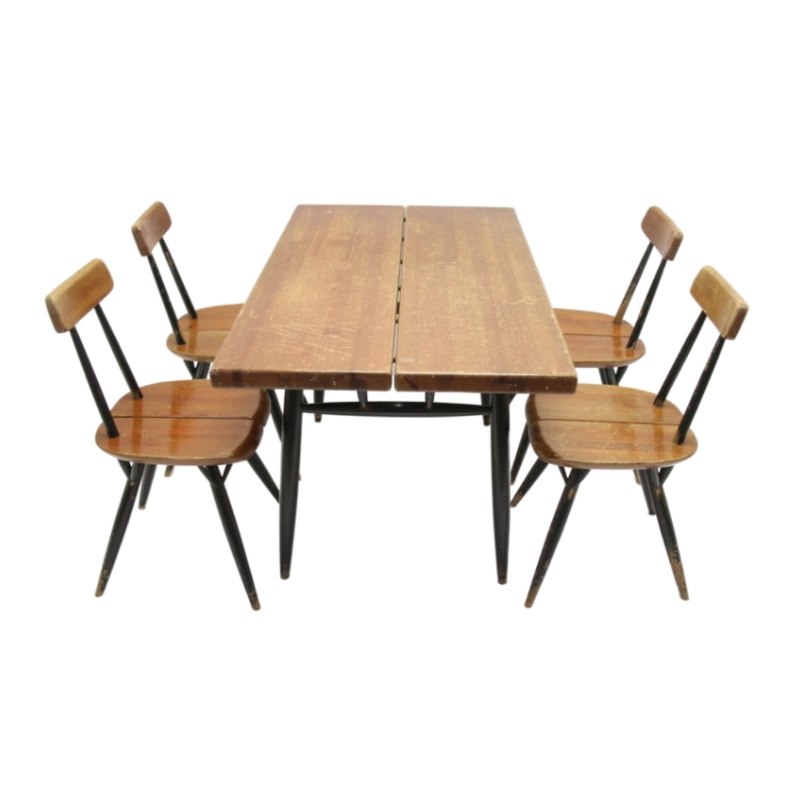I just read Dwell's story on Columbus, Indiana architecture. I have not been to Columbus, since 1983. I loved the place...both the modernist part of it and the conventional part of it.
I was glad to learn from the Dwell story that the tradition of subsidizing arch. fees for noteworthy modernist architects continues. Alas, I was disturbed to read that the town was thinking of tearing down some existing buildings by noteworthy architects.
Being professionally familiar at one time with the dynamics of development and the want/need of cities to change to revitalize their centers, I infer there are only two ways to save the existing modernist buildings and also reconfigure downtown Columbus to something more consistent with the preferences of today's residents and visitors of Columbus.
First, it seems consistent with the original intentions of the man who endowed the architecture fund to hire one of today's on-list architects to integrate the existing buildings (that are at risk of being demolished) into a new space program that would meet the contemporary city center needs in a neo-modernist idiom. In essense, retrofit and integrate these classic modernist buildings into a larger neomodernist building complex. This sort of mixing the old with the new has been done many times with considerable success in many places for eons and is a quite natural evolution of urban land uses. The Victorian gets saved and integrated with the modern. The artdeco gets mixed with the post modern. The most famous is probably Pei's modernist addition to the Georgian (?) Louvre, which though I am not very fond of Pei's addition, I was very excited by the concept. And regardless of my humble notions, his addition has been widely praised by many astute critics of architecture and culture.
The great opportunity that Columbus presents for a contemporary architect working in a neo modernist idiom, is the chance to integrate old modern with new modern. While I suspect this may have been done certain places that I am not aware of (I suppose Pelli's addition to MOMA might count), it has certainly never been undertaken in such a significant (dare I say kind of sacred) location to the legacy of modernist architecture as Columbus, Indiana.
Integrating or Moving Modernist Buildings in Columbus...Pt. 2
I would hate for Frank Gehry to integrate these grand old modernist buildings into a city center project styled after one of his Bilbao like efforts (even though I like Bilbao itself). But I would love to see Gehry paid to work in his more conventionally modernist idiom (which he is quite good at, if under-recognized for, doing) and really apply a neomodernist touch that links the old new to the new new with all the imagination he and, say, Bruce Mau might muster. Columbus needs to take another step into the new, not knock these buildings down. And modernists, postmodernists, and neomodernists, whatever their differences, ought to encourage this path for Columbus, despite the fact that it tampers with significant, existing modernist buildings.
IMHO, Columbus is one of the most important small towns in America and certainly one of the most important settlements of any size for the ongoing legacy of modernist thought and action regarding modernist architecture's cultural, aesthetic and economic feasibility now and in the future. The buildings should be saved, but they need not be slavishly preserved. They should be integrated into a next generation of modernist development. If succeeding architects could work on the likes of the Il Duomo, contemporary architects ought not be so narcissistic as to think they they cannot continue on and elaborate on something one of their predecessors did. Doing so is necessary to demonstrate the continuing, perhaps rising, relevance and efficacy of modernist architecture today.
But having said all that, if wiser heads cannot be persuaded by my argument, or can be persuaded, but cannot in the end prevail against the inexorable forces pushing for contextual change in Columbus, then is there a firm that specializes in moving modernist structures?
Integrating or Moving Modernist Buildings in Columbus...Pt. 3
I see no reason why, if prairie houses can be jacked up off their foundations and trucked places, and ancient temples can be broken down into numbered blocks, why a method cannot be found to move modernist structures also. There are people out there with obscene amounts of money who might also have refined senses of the modernist architectural legacy who could be engaged to endow moving fees for the buildings that cannot stay where they are.
Is this a violation of the original architect's intent...like colorising Citizen Kane? Undoubtedly. But modernist philosophy must not become ossified in to silly stubbornness. If the choice comes down to a Saarinen building being destroyed or moved, MOVE IT!!!! Even a merely competant architect or planner can likely find a suitable substitute site in a low density locale like the area around Columbus, Indiana. Who knows? Perhaps some modernist patron could be found to buy a large parcel that could be set aside specifically for relocation of these buildings into a kind of architectural museum that would pay for itself with a combination of rents and visitor fees. No, there is not unlimited demand for space in Columbus, far from it I suspect, but until needed these buildings could generate significant revenues simply from giving tours.
Perhaps the main message I want to convey is that in the absense of the wonderful man who set up the architecture fee endowment and apparently established and revised the list of noteworthy architects to be hired, modernist supporters must try to shoreup the foundations of the list and the endowments necessary to perpetuate and grow Columbus (as Dylan sang, "he not busy being born is busy dying"), rather than allow it to be eroded into something utterly common. If we had a Federal government that gave a damn about such things right now, this would not have to be a grass roots movement, but we do not. In fact, if we are not careful, the Bush Administration that has brought us so much de-civilization may try to route Interstate 69 through Columbus just for the Luddite appeal of making sure the small flicker of architectural and cultural progress that Columbus represents is extinguished forever.
Just as a reminder that buildings
can be moved I am including a picture of the mouving of the Antwerp Dam railway station in september/october 1907. The 700 sq.meter (6500 sq feet) building was mouved in two weeks to a new location 40 meters (125 feet) away, 2,2 meters (7 feet) higher and subsequently turned 8 degrees on the original position. To show how confident he was, the head engineer moved in with his family on the second floor. Only when the station was moved they discouvered that the second floor room where the family was living had been re-enforced with a strong wooden construction that would have left the family shaken but alive in case the building collapsed. I always thought of this as the right balance between safety and risk-taking....
This being said, I am not in favour of mouving builings around. Interesting European cities, large and small ones are often the result of selective conservation. It is unfortunate that the more interesting architectural challenge of integrating existing interesting or historically important buildings is often overlooked or dismissed in favour of the "easier" challenge to start with a clean slate. In many ways this way of thinking is similar to the one we apply to the natural environment. In both cases the problem is often the lack of a reliable method to quantify the value of the existing environment. It might not solve all problems but I think a good start would be to quantify the replacement value. In other words: Include the cost, not of the demolition, but of the re-creation of the exact same building or environment into the cost of the new building, road, dump...whatever. Too often these problems are seen as a conflict between special intrests and the common good. I suspect that any developer that would have to pay for the accurate re-construction of the landmark he wants to destroy would think twice...
http://smg.photobucket.com/albums/v662/hoera/Stations%20Antwerpen/?actio...
that is an incredible picture...
I had no idea some one could move a masonry structure INTACT! I love it!!! It looks like they built a set of railroad rails under the thing. Amazing.
I'll think on your idea about cost vs. demolition values and if I can contribute anything thoughtful I will.
We seem in agreement that the best strategy is to integrate the old into the new to create a suitable space program for today. Here, here.
Hi dc
You might enjoy this picture to...
I ignore how much actual experience there is in the use of so called "replacement value" I know that at some point it has been considered in Holland when chosing a particular lay-out for the A30 Highway. The basic idea is to estimate what it would cost to re-create the site that is considered for demolition and entering that as a cost factor in the new building. It might not be the best solution, but soemhow we have to come to grips with the zealous groups that prefer conservation at all cost and the institutionalized blindness of a large part of the developers. I am certainly not in favour of preserving everything. I have often said that given the choice between the work of a mediocre architect of the past and a mediocre one of the present, I would give the last one a chance to build rather than keeping the old. Just on the basis that the last oe is still alive and has a chance to learn...which can not be said of the one in the past. Although Darwinian law does not apply to "constructed" life I think we should be given a better chance to evaluate the historical and architectural qualities of a building before the decision is made to either keep or destroy it. As in many things in contemporary society, we count to much on the balance that will be reached by letting both extremes fight it out. Whereas the "balanced" view is rarely expressed. I am looking forward to your input.
http://smg.photobucket.com/albums/v662/hoera/Stations%20Antwerpen/?actio...
If you need any help, please contact us at – info@designaddict.com









